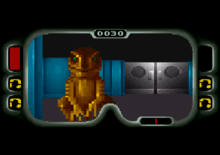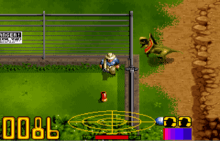Jurassic Park (SNES video game)
| Jurassic Park | |
|---|---|
_Coverart.png) European box art | |
| Developer(s) | Ocean Software |
| Publisher(s) | |
| Designer(s) |
J.H. Beard[1] C. Kerry[1] |
| Composer(s) | Jonathan Dunn[2] |
| Series | Jurassic Park |
| Platform(s) | SNES |
| Release date(s) | |
| Genre(s) | Action-adventure[1] |
| Mode(s) | Single-player |


Jurassic Park is an action-adventure video game for the Super Nintendo Entertainment System (SNES), based on the 1990 novel and 1993 film of the same name.
It was developed by Ocean Software and released in 1993 in North America and PAL regions, and published and released by Jaleco in 1994 for Japan.[1] Most of the game is viewed from a top-down view. When the player enters a building, the gameplay perspective shifts to a first-person view. Other versions of Jurassic Park, by Ocean Software and by Sega, were released as well.
In May 2015, approximately 300 copies of the game were put up for sale in an eBay listing, at a total price of $1,500.[4]
Gameplay
Jurassic Park is based on the novel and film of the same name.[5][6][7] Following a computer system failure, Dr. Alan Grant and others become trapped on an island theme park populated with dinosaurs.[8]
The player controls Grant, and begins the game armed with a cattle prod,[6] although the game also features five other weapons: tranquilizer gun, shotgun, bolas, gas grenade launcher, and missile launcher.[8] The game features seven different dinosaur enemies,[8] as well as giant dragonflies.[5] The player is given five lives, and two continues when all lives are lost.[8] Grant's health is represented by a red health bar.[5] Food and first-aid kits located throughout the game can replenish the player's health.[8]
Motion sensors set up around the island allow characters in the game to communicate advice to the player,[5][6] although some advice is deliberately malicious.[8] If Grant loses a life, the player is restarted at the last motion sensor with which Grant came into contact.[6][8] Mr. DNA, a character from the film, provides dinosaur facts to the player if the game is paused or remains idle for too long.[5][8] The player must open and close multiple gates to travel around the island.[5] The game's music changes depending on the player's location in the park.[5][9] The player is also required to collect dinosaur eggs throughout the game.[8][6]
The game's exterior portion, played from a bird's-eye view,[3] consists of a maze that is made up of jungle trees.[6] The game switches to a first-person perspective when the player enters a building.[6][3] The player must collect ID cards belonging to characters on the island in order to access certain rooms. Other rooms are completely dark and require night vision goggles to enter.[3][5][6] Jurassic Park supports the Super NES Mouse when playing first-person sequences or operating computer terminals.[8]
To win the game, the player must complete several objectives, starting with powering up a computer to re-activate the park's motion sensors. Once activated, the player's short-range motion sensor can detect nearby dinosaurs.[8][5] Subsequently, the player must determine how raptors are infiltrating the park's visitor center and stop them; prevent raptors from escaping to the mainland on a supply ship; and find the raptors' nests in underground volcanic tunnels and destroy them with a nerve gas bomb. The final objective requires the player to locate a communications center to contact a helicopter, and then reach the helipad to be rescued.[8][6] The game does not utilize a password feature.[10] The player, therefore, is required to play through the entire game in a single sitting.
Development
Ocean Software, a British video game development company, paid an undisclosed six-figure sum to secure the rights to the Jurassic Park license to develop a game based on the film.[7][11] Ocean had more developers working on Jurassic Park than any other project up to that point, which led to creative differences; however, Ocean's head of software development, Gary Bracey, said that "with such a great amount of artistic input, this was actually turned to an advantage."[7]
Jurassic Park was originally planned for release in August 1993.[12] An early demo with outdated test graphics was unveiled to a disappointed audience at Chicago's Consumer Electronics Show in June 1993.[7][13] Ocean executives in the U.K. were unaware of the demo's poor graphics, as the demo was developed at Ocean's offices in California. The developers, who were on a tight schedule, did not have time to create a better demo with improved graphics, as doing so could have compromised the game's completion date.[7] The game's final graphics were vastly improved as development continued.[7][13]
During development, Ocean had access to film stills and storyboards for the film. The game uses digitized photographs of the film's characters,[11] as well as a digitized dinosaur image from the film.[5] Ocean claimed the game was the first to utilize high-resolution backdrops.[11] According to Bracey, "Steven Spielberg said he wanted a 'ground breaking' game. We feel this has been achieved due to the development of the 3D technology in the interior sections. Essentially, we're replicating the effects of the Super FX chip in the standard SNES hardware! Everyone seems to be pretty impressed."[7] The game's first-person interior sections were created using texture mapping, a complex technique for the SNES hardware to handle.[11] The first-person segments utilized the effects of the system's Mode 7.[6][14]
The dinosaurs' behavior was based on behavior that was featured in the film.[11] Dinosaurs that were not featured in the film were added into the game for variety.[7] A scene featured earlier in the game's development depicted Grant being eaten by a Tyrannosaurus rex, accompanied by the sound of his bones being crushed. Nintendo requested that the bone-crushing sound effect be removed as it was considered too realistic.[15] The game includes inspiration from the novel, including a mission objective to prevent dinosaurs from escaping to the mainland on a supply ship.[3] The game was mastered in surround sound (Dolby Pro Logic).[8]
Reception
Edge magazine gave the game a six and criticized it for a lack of excitement, noting, "To begin with a lot of time is spent aimlessly wandering around and avoiding the dinosaurs – very little help is given in which direction you should be going and exactly what you should be doing," while also writing, "Nevertheless, given the quality of most film tie-ins, Jurassic Park is one of the better licences. With slightly improved game design it could have been the best."[9]
SNES Force magazine gave the game a 92 percent rating and praised its, "Huge playing area," and its many missions, as well as, "Superb graphics and sound."[5] Nintendo Power praised the game for "Impressive" graphics and "some game play elements that incorporate aspects of the hit movie," but also wrote, "The interior areas present few puzzles and it is easy to get lost in the outer areas."[6] Jonathan Davies of Super Play magazine gave the game an 89 percent rating and praised its colorful graphics, problem-solving tasks, and birds-eye perspective. However, Davies criticized the game for being "a bit easy" and for not incorporating the film's musical score.[3]
Electronic Gaming Monthly gave the game a 7.25 out of 10. Though they commented that the game is too easy, all but one of their four reviewers had an overall positive opinion of the game, particularly praising the sound and the use of the 3-D perspective.[10] Bob Strauss of Entertainment Weekly called the game "truly innovative" and rated it an "A-", noting its "rocking soundtrack and lush graphics."[16]
By January 1995, Jurassic Park had spent a non-consecutive period of 12 months on Nintendo Power's list of top 20 best-selling SNES games.[17] Game Informer magazine declared the Genesis version of the game somewhat superior to the SNES version in a 2012 comparison of the two games.[18]
References
- 1 2 3 4 5 6 7 "Jurassic Park release information". GameFAQs. Retrieved July 22, 2016.
- ↑ "Game Profile: Jurassic Park". SNESMusic.org. Retrieved July 22, 2016.
- 1 2 3 4 5 6 Davies, Jonathan (November 1993). "Jurassic Park review". Super Play. p. 34-36. Retrieved February 10, 2015.
- ↑ Plunkett, Luke (May 24, 2015). "A Fridge Full Of Jurassic Park Games Is Good eBay". Kotaku. Retrieved May 28, 2015.
- 1 2 3 4 5 6 7 8 9 10 11 "Jurassic Park (SNES) review". SNES Force. October 1993. p. 38–40.
- 1 2 3 4 5 6 7 8 9 10 11 "Jurassic Park". Nintendo Power. Nintendo of America. November 1993. pp. 36–43, 103. Retrieved May 13, 2016.
- 1 2 3 4 5 6 7 8 "Brace Yourself". SNES Force. Impact Magazines. pp. 14–15. Retrieved May 13, 2016.
- 1 2 3 4 5 6 7 8 9 10 11 12 13 "Jurassic Park (SNES) manual" (PDF). OldiesRising.com. p. 7–10, 12–13. Retrieved December 30, 2014.
- 1 2 "Jurassic Park review (SNES)". Edge. November 1, 1993. Archived from the original on 2015-02-11.
- 1 2 "Review Crew: Jurassic Park". Electronic Gaming Monthly (54). EGM Media, LLC. January 1994. p. 42.
- 1 2 3 4 5 "Jurassic Park: Work in Progress". SNES Force. Impact Magazines. October 1993. pp. 26–30. Retrieved May 13, 2016.
- ↑ "A behind-the-scenes look at the stars of 'Jurassic Park'". The Baltimore Sun. June 21, 1993. Retrieved February 10, 2015.
- 1 2 "Claws! The game of the film is almost here!". Super Play. September 1993. Retrieved February 10, 2015.
- ↑ "Jurassic Park". Nintendo Power. Nintendo of America. July 1993. p. 109. Retrieved May 14, 2016.
- ↑ "Sick of it yet? We're not! That Jurassic Lark". Super Play. Future Publishing. October 1993. p. 16. Retrieved May 13, 2016.
- ↑ Strauss, Bob (May 20, 1994). "Jurassic Park Interactive". Entertainment Weekly. Retrieved July 24, 2015.
- ↑ "Power Charts Super NES Top 20". Nintendo Power. Nintendo of America. January 1995. p. 100. Retrieved May 14, 2016.
- ↑ Ryckert, Dan (May 8, 2012). "Same Name, Different Game: SNES vs. Genesis". Game Informer magazine. Event occurs at 5:33-13:22. Retrieved February 19, 2015.